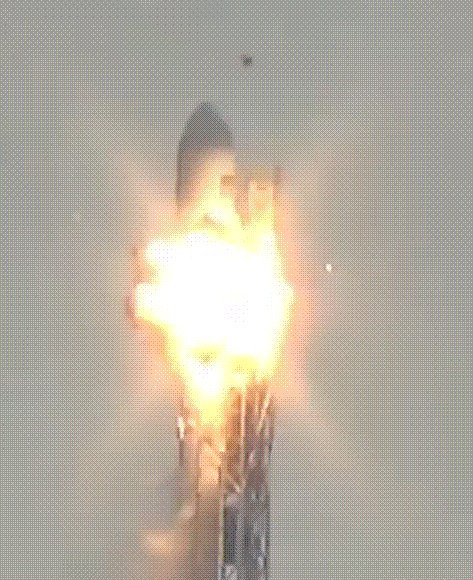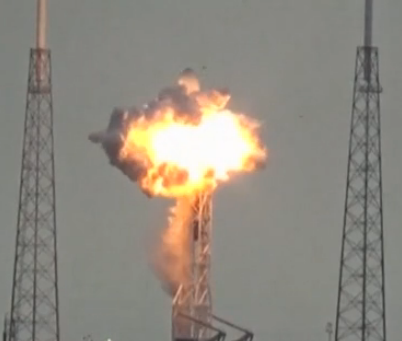Navigation
Install the app
How to install the app on iOS
Follow along with the video below to see how to install our site as a web app on your home screen.
Note: This feature may not be available in some browsers.
More options
Style variation
-
Congratulations cowski on being selected by the Eng-Tips community for having the most helpful posts in the forums last week. Way to Go!
You are using an out of date browser. It may not display this or other websites correctly.
You should upgrade or use an alternative browser.
You should upgrade or use an alternative browser.
SpaceX Comm/Facebook Satellite toast. 3
- Thread starter itsmoked
- Start date
- Status
- Not open for further replies.
At least this has nothing to do with the reuse of a returned booster. This is 'just' a normal rocket science failure. If their first reuse booster had exploded, then the repercussions might have derailed that aspect of their future plans.
Even still, the launch complex will be closed for months...
Even still, the launch complex will be closed for months...
- Thread starter
- #4
Oh oh!! A much better video.
[URL unfurl="true"]https://www.youtube.com/watch?v=_BgJEXQkjNQ[/url]
It's sooOO cool(hot?) to see all the paint facing the launch pad on the lightning diverters flashing into gas, then being sucked into the updraft caused by the bazillion kilocalorie fireball. Watch for it just after the big fireball.
Keith Cress
kcress -
[URL unfurl="true"]https://www.youtube.com/watch?v=_BgJEXQkjNQ[/url]
It's sooOO cool(hot?) to see all the paint facing the launch pad on the lightning diverters flashing into gas, then being sucked into the updraft caused by the bazillion kilocalorie fireball. Watch for it just after the big fireball.
Keith Cress
kcress -
JohnRBaker
Mechanical
From talking with some Space-X people a year or so ago, there were comments made that Musk was not very happy with the reliability of valves purchased from various manufacturers out there and while I have no direct knowledge of the current situation, the rumor at the time was that he was considering cutting-out the middleman and producing them himself as a way of getting better control of the quality. After all, when Space-X had the chance to purchase 3rd party rocket engines Musk opted to have them designed and built in-house.
John R. Baker, P.E. (ret)
EX-Product 'Evangelist'
Irvine, CA
Siemens PLM:
UG/NX Museum:
The secret of life is not finding someone to live with
It's finding someone you can't live without
John R. Baker, P.E. (ret)
EX-Product 'Evangelist'
Irvine, CA
Siemens PLM:
UG/NX Museum:
The secret of life is not finding someone to live with
It's finding someone you can't live without
msquared48
Structural
Chinese valves?
Mike McCann, PE, SE (WA)
Mike McCann, PE, SE (WA)
Have you seen that the Chinese are going to start making jet engines for passenger planes?
Funny that we have been building rocket engines since the 60's, and we can't just follow an older engine design?
But this looked like it was above the engines, or maybe the last stage.
Funny that we have been building rocket engines since the 60's, and we can't just follow an older engine design?
But this looked like it was above the engines, or maybe the last stage.
btrueblood
Mechanical
Why do a static firing of the main (1st stage) with a second stage loaded? My son told me (dunno if true) that the payload spacecraft had been loaded as well...again why risk the payload for a static firing test? And why load propellants in 2nd stage?
Sheesh, risk management must not be a subject at SpaceX.
Sheesh, risk management must not be a subject at SpaceX.
btrueblood
Mechanical
Then again, it may not be just SpaceX, since we can ask "why launch with solid rockets that have a history of partially burning thru their seals", and "why launch in cold weather when you have a history of ice buildup and subsequent breakup debris impacting the structure at launch" and "why launch without the repair kits for the reentry vehicle that you developed and included on the first few launches".
Space is hard enough without MBAs making the decisions.
Space is hard enough without MBAs making the decisions.
Just a guess, but the payload is at the top, so it was placed on the rocket prior to it being moved into place. Maybe a crane issue?
It appears failure is an option, but not a choice. Then again we don't do these things because they are easy, but because they are hard (The last part?).
It appears failure is an option, but not a choice. Then again we don't do these things because they are easy, but because they are hard (The last part?).
MikeHalloran
Mechanical
Star for btrueblood.
Static fire test results: positive for fire; is that a success to an MBA?
Risking the payload for a static test sounds colossally stupid on its face.
Mike Halloran
Pembroke Pines, FL, USA
Static fire test results: positive for fire; is that a success to an MBA?
Risking the payload for a static test sounds colossally stupid on its face.
Mike Halloran
Pembroke Pines, FL, USA
msquared48
Structural
An obvious attempt to save time... that failed.
Or...Overconfidence?
Mike McCann, PE, SE (WA)
Or...Overconfidence?
Mike McCann, PE, SE (WA)
Same guy is in charge of Tesla and its autopilot...
TTFN (ta ta for now)
I can do absolutely anything. I'm an expert! faq731-376 forum1529
TTFN (ta ta for now)
I can do absolutely anything. I'm an expert! faq731-376 forum1529
TehMightyEngineer
Structural
btrueblood said:Why do a static firing of the main (1st stage) with a second stage loaded? My son told me (dunno if true) that the payload spacecraft had been loaded as well...again why risk the payload for a static firing test? And why load propellants in 2nd stage?
Sheesh, risk management must not be a subject at SpaceX.
(I'm definitely not a rocket engineer, just an enthusiast) I believe 2nd stage is integrated and fueled to test the fuel loading and associated hardware on the 2nd stage. As for the payload they recently got approved by their insurance to integrate the payload before the static fire which apparently saves them a day of work. Obviously that was a bad idea and I suspect they will be doing some re-evaluation of risk management to avoid one accident turning into many others.
I wonder if rushing to try to save days was a result of the failure of CRS-7 and trying to catch up to their launch schedule.
Professional and Structural Engineer (ME, NH, MA)
American Concrete Industries
darthsoilsguy2
Geotechnical
i'm just wondering if Eng-Tips is weighing on SpaceX's decision to not simulate the payload... check out the banner ad HAH!
The gap between simulation and reality is filled with chasms. The 787 is a poster child for that; model-based design and simulation still didn't keep the plane from having a multitude of problems that put the plane more than 2 years behind production release schedule.
TTFN (ta ta for now)
I can do absolutely anything. I'm an expert! faq731-376 forum1529
TTFN (ta ta for now)
I can do absolutely anything. I'm an expert! faq731-376 forum1529
Space is hard
Pushing the boundaries is harder
SpaceX is the first one to use sub-cooled LOX and chilled RP1.
They do this to get more fuel in the rocket; more fuel in the rocket works to defy the tyranny of the rocket equation. Everyone else (NASA, ULA, ESA, China, Russia as far as I can tell) uses LOX at boiling point, so there is a lot of experience there, but the experience is limited on LOX near the freezing point especially for high volume handling of the stuff. O2 melting/freezing point -361°F, Boiling/condensing point -297°F. That extra 64 degrees can make the difference in piping, hoses, valves, you name it.
As for why load the second stage, the static fire test is more than just a test of the first stage engines, it is a test of the entire launch procedure, so doing everything as if it were a real launch is part of the test. Their corrective actions during a launch is very limited due to the design of the booster, they want to launch on the first second of the window otherwise the too much LOX warms up and boils off and the RP1 will also warm up and spill out. Doing a full launch test during the static fire test proves out the other procedures so launch day goes smoother.
Good luck to SpaceX to finding the cause and the causes behind the cause.
Hydrae
Pushing the boundaries is harder
SpaceX is the first one to use sub-cooled LOX and chilled RP1.
They do this to get more fuel in the rocket; more fuel in the rocket works to defy the tyranny of the rocket equation. Everyone else (NASA, ULA, ESA, China, Russia as far as I can tell) uses LOX at boiling point, so there is a lot of experience there, but the experience is limited on LOX near the freezing point especially for high volume handling of the stuff. O2 melting/freezing point -361°F, Boiling/condensing point -297°F. That extra 64 degrees can make the difference in piping, hoses, valves, you name it.
As for why load the second stage, the static fire test is more than just a test of the first stage engines, it is a test of the entire launch procedure, so doing everything as if it were a real launch is part of the test. Their corrective actions during a launch is very limited due to the design of the booster, they want to launch on the first second of the window otherwise the too much LOX warms up and boils off and the RP1 will also warm up and spill out. Doing a full launch test during the static fire test proves out the other procedures so launch day goes smoother.
Good luck to SpaceX to finding the cause and the causes behind the cause.
Hydrae
- Thread starter
- #20
I'm guessing the fully stacked testing is expected to prove the engine thrust, fuel valves, pressure sensors, and the full launch vehicle's electrical connections are not vibrating apart. It's not expected to be a blow-up event like the much more hazardous launch is. Indeed it seems like the problem was completely unrelated to the vehicle and really a plumbing-to-the-vehicle issue. That's why I think the payload is present and will continue to be present in all future missions.
Looking at the initial explosion you can see, what probably is, a pipe fitting being launched up and away from the fueling connection area.
Note the two pieces in this frame.

I wonder if someone left a greasy fingerprint somewhere that the LOX took offense at.
Keith Cress
kcress -
Looking at the initial explosion you can see, what probably is, a pipe fitting being launched up and away from the fueling connection area.
Note the two pieces in this frame.

I wonder if someone left a greasy fingerprint somewhere that the LOX took offense at.
Keith Cress
kcress -
- Status
- Not open for further replies.
Similar threads
- Locked
- News
- Replies
- 5
- Views
- 449
- Replies
- 47
- Views
- 2K
- Replies
- 6
- Views
- 398
- Replies
- 0
- Views
- 129
- Locked
- Question
- Replies
- 49
- Views
- 2K

